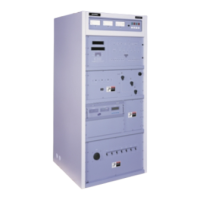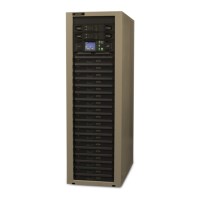3/6/08 888-2463-001 4-29
WARNING: Disconnect primary power prior to servicing.
Section 4 Theory of Operation
Diamond Series™
The output power sample enters at J6 and reports the power out to the micro. Three
sections of U3 (pins 1, 7 and 10) are for the fast protection of the output of the module.
The Output Overdrive signal is NOR’ed with other fault signals at U30 to create the
fault interrupt request-L to the micro which will turn the module OFF.
Other signals that will turn OFF the module through U30 are input overdrive, excess
reflected power, if the module is out of the socket (MOD_POS_OK) and a manual
interrupt request at JP2.
These signals are latched at U42 to report the cause of the fault to the micro so it can
display the reason the module was turned OFF.
4.9.1.4 Watchdog circuits
The micro sends out an active HIGH at pin 78 to energize the DC switch assembly. This
HIGH is applied to AND gate U20 pin 2. Pin 1 of the AND gate normally gets an active
HIGH from watchdog one-shot U18.
The micro sends a watchdog trigger pulse to the one-shot U18-4. This pulse period is
less than 1 ms, which is faster than the time period of the one-shot, so the one-shot is
unable to return to its’ stable state. The output will remain HIGH as long as the input
trigger is present.
When the micro has a problem, the watchdog trigger pulses stop, allowing the Q output
to go LOW, going through the AND gate, turning the pass FETs OFF.
A second watch dog also receives the trigger pulse for the micro, when it detects a loss
of the trigger it will reset the microprocessor. The micro can be manually reset at S1 (8-
9). Green LED DS3 is illuminated when the micro is functioning correctly. When the
micro has failed, DS3 will blink, indicating a micro failure.
4.9.1.5 I.D. and Configuration
Cabinet and module identification are present at J5 (10-16) and are latched by U17 to
send to the micro through the data bus.
S1 is configuration disable, used for test purposes only. The contacts in S1 are normal
OPEN to allow full function of the module. However under some circumstances, it may
be necessary to disable these functions to observe the fault or test the module. When
any of the switches are closed, the following functions will be disabled:
• 1-disables MOSFET protection
